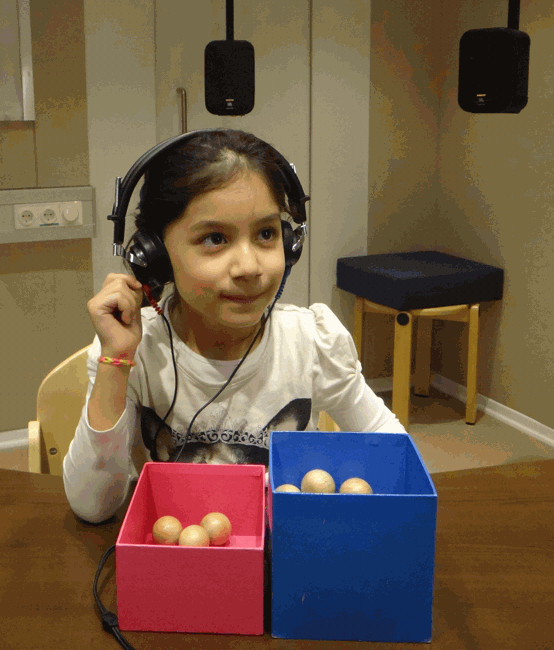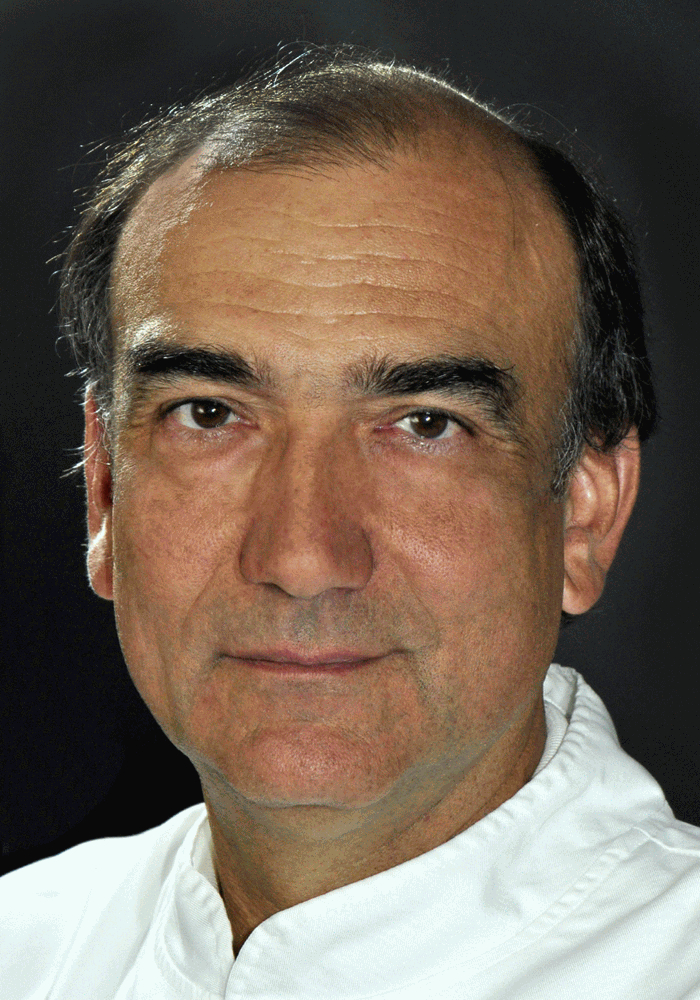Hearing, Speech and Voice Disorders
Research Focus
General Facts
Research
Selected Publications
Selected Funding, Collaboration
Keywords: Dysphagia, hearing disorders, hearing implants, hearing rehabilitation, sound localisation & speech understanding with hearing implants, tinnitus, voice disorders
Research (ÖSTAT Classification) :103002, 301401, 302023,302027, 302029
Research Focus
- Assessing the auditory performance (e.g. speech understanding, sound source localisation) of patients with hearing implants or hearing aids.
- Assessing the neurocognitive processes associated with healthy and impaired language acquisition.
- Developing objective methods for fitting hearing implants in children.
- Evaluating the improvement of quality of life after hearing implantation.
- Identifying factors that influence the outcome of hearing implantation and hearing rehabilitation.
General Facts
The Department for HSV Disorders is Austria’s largest institution in the fields of clinical audiology, paediatric audiology and phoniatrics. It offers a full range of clinical services for the diagnosis and treatment of hearing, speech, language and swallowing disorders as well as childhood learning problems. The Hearing Centre sub-unit of the department provides a compact infrastructure for the diagnosis, treatment and rehabilitation of hearing disorders. The research facilities of the department include the psychoacoustics laboratory and the cognitive neuroscience laboratory. In the latter, neural mechanisms that underlie language processing and acquisition in adults and children are investigated by means of electroencephalography (EEG), functional near-infrared spectroscopy (fNIRS) and magnetic resonance imaging (MRI). In the psychoacoustics laboratory, which is equipped with an anechoic chamber for high-precision acoustic measurements, human hearing functions are tested under very specific conditions, including the use of hearing implants. On a national scale, the HSV department is the driving force behind the Austrian universal neonatal hearing screening programme. In addition to clinical services and scientific research, the education of medical and logopaedic students is also major task of the department.
Research
Stapedius Reflex in Cochlear Implant (CI) Patients
Kurt Stephan
The postoperative measurement of the stapedius reflex elicited via CI is a well-established, objective method for fitting cochlear implants in children. In it, the electrically-evoked stapedial reflex threshold (ESRT) is determined through impedance audiometry and the results are used for setting the level of maximum stimulation intensity in the fitting of the CI speech processor. Effective application of this method requires normal middle ear function – a condition not always present in young children. A further limiting factor for effective application is the lack of easy-to-use, optimised instrumentation. In order to overcome these constraints of ESRT testing, a computerised testing system was developed. This system provides simultaneous impedance monitoring of the stapedius reflex in real time during electrical stimulation via CI, with minimum effort for the investigator. Continuous evaluation of the system was undertaken and results were used both to improve and to expand its applicability within the clinical routine.

Fig. 1: The hearing of a little girl is tested using play audiometry.
Sound Source Localisation in Patients with a Cochlear Implant and a Hearing Aid
Josef Seebacher
Sound source localisation (SSL) skills were investigated in patients with asymmetric hearing loss, who use a cochlear implant (CI) on one side and a hearing aid (HA) on the other side. Previous studies found that patients with CI and HA do not perform perfectly in binaural listening tasks, including SSL. We hypothesised that their limited performance may be due to the lack of synchronisation of the left and right sound signals. The signal transfer via cochlear implant is faster than the signal transfer via hearing aid, resulting in considerable timing differences between the CI side and the HA side. In the current experiment, an attempt was made to compensate for this time lag by delaying the CI signal. Results confirmed the hypothesis that a delay on the CI side has an impact on patients’ SSL abilities. SSL performance was best when the signal delay in the CI was slightly shorter than the processing time of the corresponding HA. Since newer HA and CI programming methods allow for adjustment of the timing of the transferred signal, some degree of synchronisation of the two devices can be achieved through CI or HA fitting. To improve knowledge of these processes and to optimise fitting strategies, further investigations on this topic are planned.
Outcome of Hearing Implantation
Viktor Weichbold, Franz Muigg
This project is a compilation of several studies investigating factors that are assumed to influence the outcome of cochlear or middle ear implantation in people with hearing loss. It includes research into the impact of personality factors on quality of life after cochlear implantation as well as a study on the question whether and to what degree cochlear implantation improves quality of life in persons with single-sided deafness. It also includes research into the cost-benefit ratio of hearing implantation. The goal of these studies is to increase knowledge of the overall effects of hearing implantation and to provide evidence-based information for counselling patients who are candidates for a hearing implant.
Cognitive Capabilities of Deaf Older Patients with and without Cochlear Implant (Multicentre Study)
Viktor Weichbold, Christian Gstrein
Older people with profound hearing loss are at risk of cognitive decline. It is hypothesised that aural rehabilitation with a CI counters a decline in cognitive capabilities. This hypothesis was assessed as part of a multicentre study, in which the HSV Department participated. Patients aged 60 years or more, who had a high degree of hearing loss, were observed for two years. Some of them had received a CI, others not. Neuropsychological tests served as outcome measures and were administered at the beginning of the study (i.e. before cochlear implantation) and one and two years thereafter. Results were pooled with findings from other participating centers. Results showed that particular cognitive abilities did less worsen in patients supplied with a CI than in patients with no CI. However, hearing rehabilitation had no effect on age-related deterioration of cognitive abilities.
Identifying Early Neuronal Markers in Infants at Familial Risk of Dyslexia
Sonja Rossi
Developmental dyslexia is a disorder that affects reading and writing abilities in school-aged children. The present project aims to identify early neuronal markers in infants under the age of 2 years and therefore before possible manifestation of dyslexia. By applying two neuroscientific methods simultaneously, electroencephalography (EEG) and functional near-infrared spectroscopy (fNIRS), we are investigating the differentiation of linguistic rules in the native language by comparison with the rules of a foreign language, in order to identify early neuronal abnormalities. Familial risk of dyslexia is classified by either a parent or an older sibling suffering from developmental dyslexia. Neuronal markers in the focus of investigation include atypical brain lateralisation and lacking or delayed discrimination ability.
TRALA Project: How does a TRAumatised Brain Learn LAnguage?
Sonja Rossi, Sarah Steber
We know that experiencing stressful life events in general and suffering from post-traumatic stress disorder (PTSD) can have a massive impact on cognitive and emotional function. The present project focuses on two cognitive functions that are crucial for successful language processing and language learning and that are affected in PTSD patients: identification of emotional states (i.e. angry, happy and neutral prosody in pseudowords), and memory storage capacity after implicit semantic word-picture training. We assess neural mechanisms in the brain by means of electroencephalography (EEG) and functional near-infrared spectroscopy (fNIRS), as these can provide a direct, implicit measure of the underlying processing strategies. Compensatory neural mechanisms are expected in PTSD patients, by comparison with healthy control subjects.
Neuronal Signatures of Speech Comprehension in Cochlear Implant Patients
Sonja Rossi, Josef Seebacher, Anja Hahne
In patients with profound hearing loss, a cochlear implant (CI) provides effective access to speech. However, the information transfer to the auditory system is completely different between CI users and listeners with natural hearing. The particular rehabilitation process that CI listeners go through is unknown, but the human brain obviously has sufficient plasticity to integrate the new type of informational transfer. This study investigates fast, dynamic, neural mechanisms together with activation patterns in the brain by means of two methods applied simultaneously: electroencephalography (EEG) and functional near-infrared spectroscopy (fNIRS). In Experiment 1, single-sided deaf CI users and normal-hearing subjects are assessed whilst listening to monaurally or binaurally presented, semantically correct and incorrect sentences. In Experiment 2, CI users and healthy controls listen to spoken and sung sentences. The investigation focuses on neuroplastic mechanisms during the language rehabilitation process of CI users.
Selected Publications
- Steber S, Rossi S. (2020) So young, yet so mature? Electrophysiological and vascular correlates of phonotactic processing in 18-month-olds. Dev Cogn Neurosci. 2020; 43:100784.
- Steber S, König N, Stephan F, Rossi S. (2020) Uncovering electrophysiological and vascular signatures of implicit emotional prosody. Sci Rep. 2020; 10(1):5807.
- Rossi S, Gugler MF, Rungger M, Galvan O, Zorowka PG, Seebacher J. (2020) How the Brain Understands Spoken and Sung Sentences. Brain Sci. Jan 8;10(1). pii: E36. doi: 10.3390/brainsci10010036.
- Muigg F, Weichbold VW, Kuehn H, Seebacher J, Galvan O. (2020) Does Cochlear Implantation Affect Openness-to-Experience in Profound Postlingual Hearing Loss? J Deaf Stud Deaf Educ. Oct 2: enaa031. doi: 10.1093/deafed/enaa031. Online ahead of print.
- Muigg F, Bliem HR, Kühn H, Seebacher J, Holzner B, Weichbold V. (2020) Cochlear Implantation in Adults with Single-Sided Deafness: Generic and Disease-Specific long-term Quality of Life. Eur Arch Oto-Rhino-Laryngol. 277(3):695-704
- Muigg F, Bliem HR, Holzner B, Kühn H, Zorowka PG, Weichbold VW (2019) Do Personality Factors Assessed Before Cochlear Implantation Predict Hearing-Related Quality Of Life After Cochlear Implantation in Postlingually Deafened Adults? Ear Hear. 40(2):418-425
- Seebacher J, Weichbold V, Schörg P, Koci V, Magele A, Zorowka P, Sprinzl G (2020) Subjective Hearing Impression and Quality of Life in Patients With Bilateral Active Middle Ear Implants. Otol Neurotol. Jul;41(6):e641-e647.
- Seebacher J, Franke-Trieger A, Weichbold V, Zorowka P, Stephan K. (2019) Improved interaural timing of acoustic nerve stimulation affects sound localization in single-sided deaf cochlear implant users. Hear Res. 371:19-27.
- Ruedl G, Pocecco E, Kopp M, Burtscher M, Zorowka P, Seebacher J. (2019) Impact of listening to music while wearing a ski helmet on sound source localization. J Sci Med Sport. 22 Suppl 1:S7-S11.
Selection of Funding
- Language development in preterm infants by identifying early neuronal markers, Fonds zur Förderung von Wissenschaft und Forschung an den Universitätskliniken Innsbruck, PD Mag. Dr. Sonja Rossi
- Singing or speaking? This is the question. Neural signatures in patients with hearing impairments, Tiroler Wissenschaftsfonds, PD Mag. Dr. Sonja Rossi
Collaborations
- Charité University Medicine, Berlin, Germany
- Clinic for Cognitive Neurology, University Hospital, Leipzig, Germany
- Department of Subject Education, Leopold-Franzens University Innsbruck, Austria
- Faculty of Education, University of Leipzig, Germany
- Institute of Psychology, Leopold Franzens University Innsbruck, Austria
- Max Planck Institute for Human Cognitive and Brain Sciences, Leipzig, Germany
- MED-EL, Innsbruck, Austria
- Saxonian Cochlear Implant Center, Technical University of Dresden, Germany
Devices & Services
- Audiology unit
- Medical outpatient unit
- Pediatric Audiology unit
- Logopedic unit
- Psychology unit
- Lab for Psycho-Acoustics
- Lab for Cognitive Neuroscience
 o. Univ.-Prof. Dr.med.univ. Patrick Zorowka
o. Univ.-Prof. Dr.med.univ. Patrick Zorowka
Director
Contact:
Anichstraße 35
6020 Innsbruck
Austria
E-mail: hss@tirol-klinken.at
Phone: +43 512 504 23218
Fax: +43 512 504 23216
www.hss-innsbruck.at



